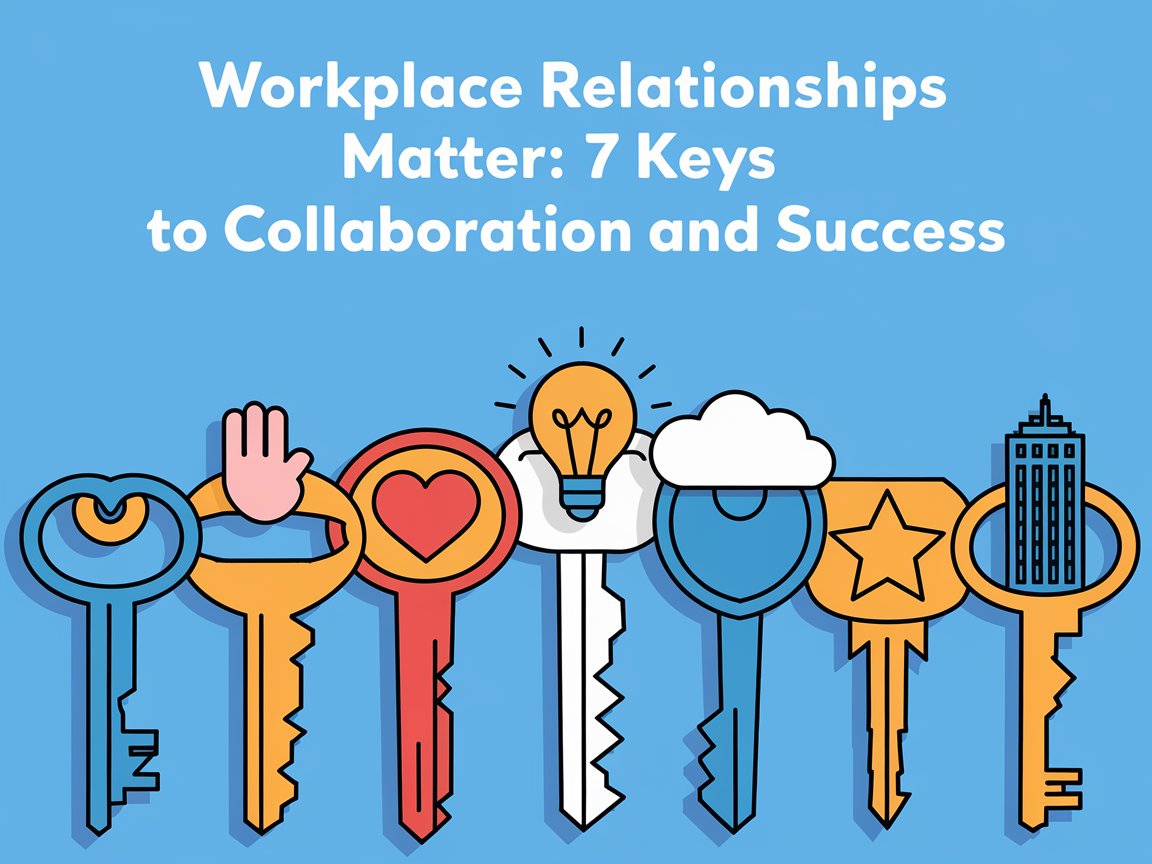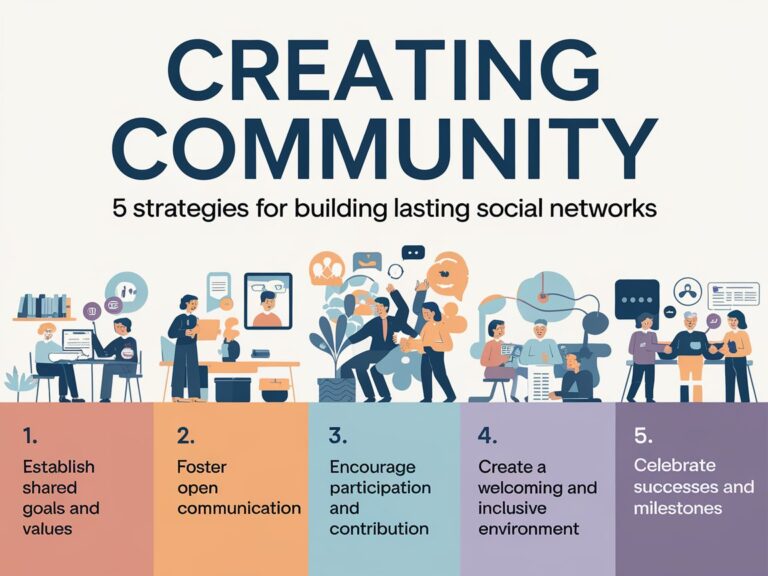Workplace Relationships Matter: 7 Keys to Collaboration and Success
In today’s fast-paced business environment, the importance of workplace relationships cannot be overstated.
Strong interpersonal connections among employees foster a culture of collaboration, creativity, and productivity. When team members feel comfortable and valued, they are more likely to share ideas, work together on projects, and support one another in achieving common goals.
This article explores seven key elements that contribute to successful workplace relationships and ultimately drive collaboration and success.
Key 1: Open Communication
Open communication is the cornerstone of any effective workplace relationship. It allows for the free exchange of ideas, feedback, and information, ensuring that everyone is on the same page. To foster an environment of open dialogue, organizations should encourage transparency at all levels. Leaders should model open communication by sharing relevant information and being approachable.
Techniques for fostering open communication include:
- Regular Check-Ins: Schedule regular one-on-one meetings and team check-ins to discuss ongoing projects and address any concerns. These meetings provide a platform for employees to voice their thoughts and seek clarification.
- Encourage Feedback: Create a culture where feedback is welcomed and valued. Encourage team members to share their opinions on processes and outcomes, and ensure they know their input is taken seriously.
- Active Listening: Listening is as crucial as speaking. Team members should practice active listening, which involves fully concentrating on what is being said rather than merely waiting for their turn to speak. This helps in understanding different perspectives and fostering mutual respect.
The benefits of open communication extend beyond individual relationships; they enhance teamwork, reduce misunderstandings, and improve overall productivity. When employees feel heard, they are more engaged and motivated, leading to a more dynamic workplace.
Key 2: Trust Building
Trust is fundamental to any relationship, and the workplace is no exception. When team members trust one another, they are more likely to collaborate effectively and share their ideas without fear of judgment. Building trust takes time and effort, but it can be achieved through several strategies:
- Consistency: Be reliable and consistent in your actions and words. Follow through on promises and commitments to show that you can be counted on. This consistency helps to build a foundation of trust among colleagues.
- Transparency: Share information openly and be honest about challenges and mistakes. When team members see that you are transparent, they are more likely to reciprocate.
- Empathy: Understanding and respecting each other’s feelings and perspectives can significantly enhance trust. Show empathy by being supportive and offering assistance when colleagues face challenges.
The consequences of a lack of trust can be detrimental to team dynamics. When trust is absent, employees may withhold information, avoid collaboration, or engage in unhealthy competition. Conversely, when trust is present, teams can work more cohesively, resulting in better outcomes and a more enjoyable work environment.
Key 3: Collaboration Opportunities
Creating opportunities for collaboration is vital for enhancing workplace relationships. Collaboration brings diverse perspectives and skills together, leading to innovative solutions and improved results. Here are some effective strategies for encouraging collaboration:
- Cross-Departmental Projects: Encourage collaboration between different departments on projects. This not only fosters relationships but also helps employees gain a better understanding of the organization as a whole.
- Team Workshops: Organize workshops that focus on team-building exercises and problem-solving activities. These workshops can help break down barriers and encourage team members to work together in a relaxed setting.
- Collaborative Tools: Leverage technology to facilitate collaboration. Tools like project management software, chat applications, and shared documents can help teams work together more efficiently, regardless of their physical locations.
Real-world examples of successful collaboration can inspire teams to work together. For instance, when companies implement collaborative projects that bring together employees from various departments, they often see increased creativity and problem-solving capabilities.
Key 4: Recognition and Appreciation
Recognition and appreciation play a significant role in strengthening workplace relationships. When employees feel valued for their contributions, they are more likely to engage and invest in their work. Here are various ways to show appreciation:
- Verbal Acknowledgment: Regularly acknowledge and thank team members for their efforts, whether during team meetings or through informal conversations. A simple “thank you” can go a long way in boosting morale.
- Formal Recognition Programs: Implement recognition programs that celebrate achievements, whether through awards, shout-outs, or employee-of-the-month initiatives. This not only recognizes individual efforts but also encourages others to strive for excellence.
- Personalized Gestures: Tailor recognition to the individual’s preferences. Some may appreciate public recognition, while others might prefer a private note of appreciation. Knowing your colleagues’ preferences shows that you care about their feelings.
The impact of recognition extends beyond boosting morale; it fosters a culture of appreciation and motivates employees to perform at their best. When team members feel valued, they are more likely to collaborate effectively and support one another.
Key 5: Conflict Resolution
Conflicts are natural in any workplace, but how they are managed can significantly affect relationships. Instead of avoiding conflicts, organizations should adopt strategies for effective conflict resolution:
- Acknowledge the Conflict: Recognize that conflicts exist and address them promptly. Avoiding conflict can lead to resentment and further issues down the line.
- Encourage Open Dialogue: Create an environment where team members feel safe discussing their differences. Encourage them to express their perspectives and listen to one another.
- Find Common Ground: Focus on shared goals and interests to find a resolution. By emphasizing common objectives, team members can work together to overcome differences.
Transforming conflicts into opportunities for growth can enhance workplace relationships. When conflicts are resolved constructively, they can lead to improved understanding, strengthened bonds, and a more cohesive team.
Key 6: Social Interactions
Informal social interactions among colleagues are essential for building strong relationships. These interactions help humanize team members and foster a sense of belonging. Here are some ideas for encouraging social interactions:
- Team Building Activities: Organize regular team-building events, whether it’s a lunch outing, a game day, or an offsite retreat. These activities allow employees to connect on a personal level outside of their usual work environment.
- Casual Gatherings: Encourage informal gatherings, such as coffee breaks or after-work happy hours. These relaxed settings provide opportunities for employees to bond and share experiences.
- Celebrate Milestones: Acknowledge birthdays, work anniversaries, and personal achievements. Celebrating milestones fosters a sense of community and shows that the organization values its employees.
Creating a supportive social environment enhances collaboration and strengthens relationships. When employees feel connected and supported, they are more likely to work together effectively.
Key 7: Continuous Improvement
Promoting a culture of continuous improvement is crucial for fostering strong workplace relationships. When organizations encourage personal and professional development, employees feel valued and motivated to contribute. Here are some strategies for fostering continuous improvement:
- Encourage Professional Development: Provide opportunities for training, workshops, and skill-building sessions. Investing in employees’ growth shows that the organization values their contributions and wants them to succeed.
- Solicit Feedback: Regularly seek feedback from team members on processes, projects, and interpersonal dynamics. This not only helps identify areas for improvement but also demonstrates that employees’ opinions matter.
- Adapt and Evolve: Encourage teams to be flexible and open to change. The ability to adapt to new situations fosters resilience and strengthens relationships as colleagues work together to navigate challenges.
By emphasizing continuous improvement, organizations can create a culture of growth that benefits both individuals and teams. This commitment to development not only enhances skills but also strengthens relationships through shared learning experiences.
Conclusion
In conclusion, strong workplace relationships are vital for fostering collaboration and achieving success. The seven keys discussed—open communication, trust building, collaboration opportunities, recognition and appreciation, conflict resolution, social interactions, and continuous improvement—serve as essential components in creating a positive work environment.
Organizations that prioritize these elements will not only enhance interpersonal relationships but also drive productivity and innovation. As employees feel more connected and supported, they are better equipped to collaborate, share ideas, and work toward common goals. Ultimately, investing in workplace relationships is an investment in the organization’s future success. By taking proactive steps to nurture these connections, leaders can create a thriving workplace where everyone can contribute and grow.



